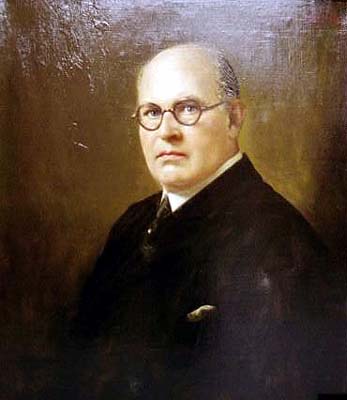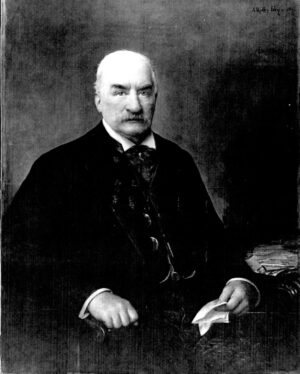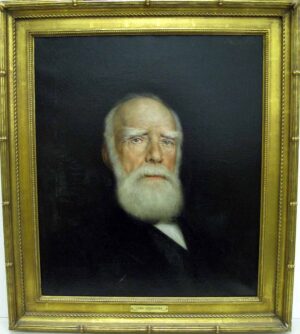THOMPSON, William “Boyce”
Description:
Bust-length without hands, facing left, balding with round, dark-rim spectacles. Oil on canvas, 30.1/4” x 24.1/4”
Location:
New York State Museum (H-2003.41.94)
Provenance:
New York State Chamber of Commerce, New York. Gift of Jessica Dragonette, c. 1948. Given to New York State Museum in 2003 by The Partnership of New York City Inc. after the NYCOC collection was partially sold off.
The sitter was born May 13, 1869 and died on June 27, 1930. He was an American mining engineer, financier, prominent in the Republican party, philanthropist and founder of Newmont Mining Corporation. Born in Virginia City, Montana, and raised in Butte, he was schooled in the rough mining towns of southwest Montana – but also at Phillips Exeter Acadmy, and the Columbia School of Mines. During the 1890s he joined his father, William, one-time mayor of Butte, in Montana mining and lumber ventures, before moving East to become a mine promoter and stock broker. Thompson was one of the significant early twentieth century mine operators that discovered and exploited vast copper deposits that revolutionized Western American mining, and reaped for themselves tremendous fortunes. In 1912 he built a mansion at Yonkers, and during the 1920s, near Superior, Arizona, he built a winter mansion, Picket Post House, overlooking the beautiful desertscape and gardens he created at what is now the Boyce Thompson Arboretum State Park. He died on pneumonia in 1930. His daughter, Margaret Thompson, and his wife, Gertrude Hickman Thompson, inherited most of his wealth.
Bibliography of sitter:
Hermann Hagedorn, The Magnate (1935)
—
In her autobiography Faith is a Song (New Jersey, 1951), pp. 300-301, Jessica Dragonette writes of a visit she paid to the New York Chamber of Commerce, then at 65, Liberty Street and a tour given of the building by Don Mullin, membership secretary and of how she discovered four pictures by Muller-Ury on the walls:
‘With a surge of enthusiasm, I said to Mr. Mullin, “I have a portrait of a great American by Muller-Ury that would be at home here. Will you accept it?” Mr. Mullin, obviously nonplussed by my offer, stuttered “You have, but how can that be? Both men were before your time.”’
After describing her friendship with the artist in his last years, and how she had acquired many pictures from his estate, she writes:
‘Though I was familiar with most of Muller-Ury’s pictures, there were a few unidentified…I consulted Hermann Hagedorn, poet and biographer, who identified several. Then I wrote to the respective families giving them first chance to acquire the canvases. In the case of Boyce Thompson, the Newmont Mining Corporation magnate, his daughter showed no interest, and his estate set a modest fee for the privilege of destroying the picture. Outraged at the thought of annihilating Muller-Ury’s work, I decided to place the portrait where it would do credit to both men. After Herman Hagedorn’s assertion that it was excellent, I sought out Charles Fanning Ayer, Boyce Thompson’s partner for forty years, who pronounced it a living likeness.
That day in the Chamber, I knew the picture belonged among Americans of distinction, in company with the other Muller-Ury portraits…’



![OELRICHS, [Natalie] Lily (Later Mrs Peter Martin; Later Duchess of Mecklenburg)](https://www.muller-ury.com/wp-content/uploads/2018/11/digiScanLtd.com-Conrad69-1-300x511.jpg)

